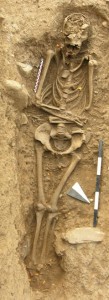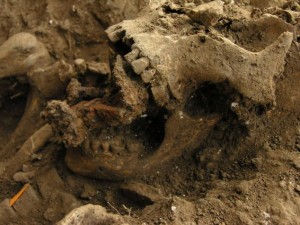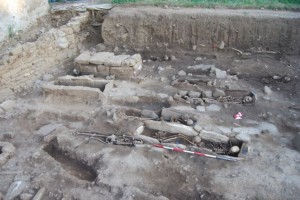 An archaeological team excavating the Tuscan port town of Piombino hoping to find the remains of its patron saint has instead uncovered the skeletal remains of two 13th century women of questionable repute. Approximately 25-30 years old at time of death, they were both buried in the bare earth, without a coffin or even a shroud, very much against custom.
An archaeological team excavating the Tuscan port town of Piombino hoping to find the remains of its patron saint has instead uncovered the skeletal remains of two 13th century women of questionable repute. Approximately 25-30 years old at time of death, they were both buried in the bare earth, without a coffin or even a shroud, very much against custom.
One of women had seven curved, one-and-a-half-inch-long nails placed in her mouth after death and 13 more nails jammed into the ground all around her body. Archaeologists speculate that the ones around her body were used to nail the body to the ground in some kind of exorcism ritual to prevent her using witchcraft to rise from the dead.
The other woman was buried with a leather pouch holding 17 bone dice. Games of chance were against civil and ecclesiastic law during the Middle Ages, and although the laws were constantly flouted, a women associated with dice was a woman associated with immorality. Also, 17 was and remains an extremely unlucky number in Italy. (The story I’ve heard about why it’s unlucky is that the Roman number for 17, XVII, is an anagram of “vixi” which is Latin for “I have lived” which is just like saying you’re dead and is therefore an ill omen. No idea if that’s true.)
 L’Aquila University archaeologist Alfonso Forgione, the dig leader, notes that these burials are unique in his experience. Not only are they strangely bare and contain those odd accouterments, but they are also in consecrated ground. There’s a chapel on the grounds purportedly marking the burial spot of Saint Cerbonius, the sixth century A.D. bishop and patron saint of Piombino. The team was looking for the saint’s burial and for the remains of a medieval cathedral that was once dedicated to him when they found the ladies. If the women were social outcasts, one of them demonic, the other degenerate, neither of them worthy of a decent burial, how come they got to go to their eternal rest in a cathedral cemetery next to a saint?
L’Aquila University archaeologist Alfonso Forgione, the dig leader, notes that these burials are unique in his experience. Not only are they strangely bare and contain those odd accouterments, but they are also in consecrated ground. There’s a chapel on the grounds purportedly marking the burial spot of Saint Cerbonius, the sixth century A.D. bishop and patron saint of Piombino. The team was looking for the saint’s burial and for the remains of a medieval cathedral that was once dedicated to him when they found the ladies. If the women were social outcasts, one of them demonic, the other degenerate, neither of them worthy of a decent burial, how come they got to go to their eternal rest in a cathedral cemetery next to a saint?
Forgione speculates that they may have had the advantage of powerful friends and families surviving them who arranged for them to have at least a chance at heaven by ensuring their bodies were placed in consecrated ground.
 The excavation will continue through the end of the month. They have already found 350 burials in four eight-by-ten meter (26 by 33 feet) sites on each side of the chapel, and there are strong indications that the cemetery goes on for another 65 feet inland and another 33 feet or so towards the sea. Such a large, well-populated cemetery indicates that little Piombino, the only known Etruscan port city, remained a thriving town through the Middle Ages.
The excavation will continue through the end of the month. They have already found 350 burials in four eight-by-ten meter (26 by 33 feet) sites on each side of the chapel, and there are strong indications that the cemetery goes on for another 65 feet inland and another 33 feet or so towards the sea. Such a large, well-populated cemetery indicates that little Piombino, the only known Etruscan port city, remained a thriving town through the Middle Ages.
Archaeologists are working against the clock, though. The cliff side is eroding faster than they can dig. There are bones visibly jutting out, to the delight of many a tourist taking a romantic walk on the beach, but they can’t be removed for fear that the entire promontory will crumble like a Jenga game.